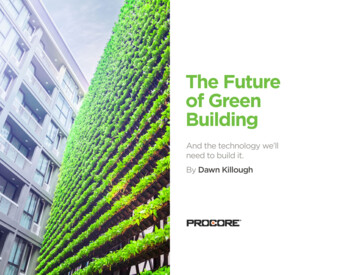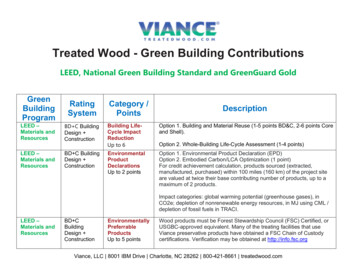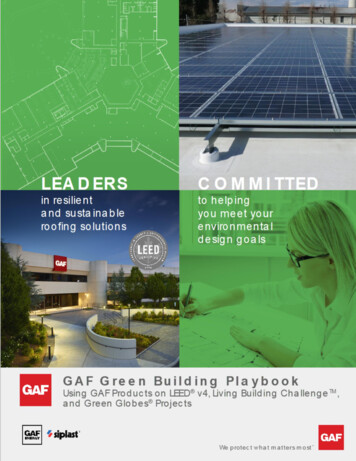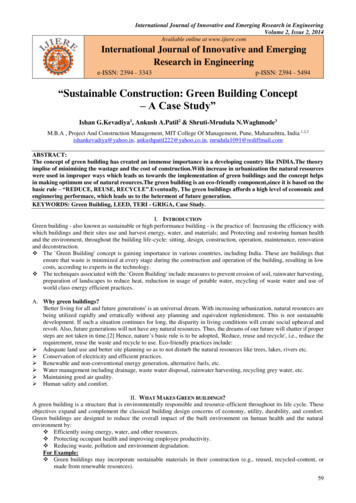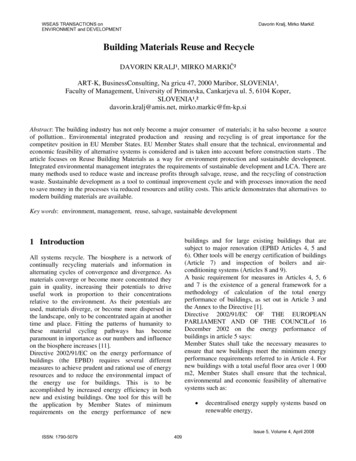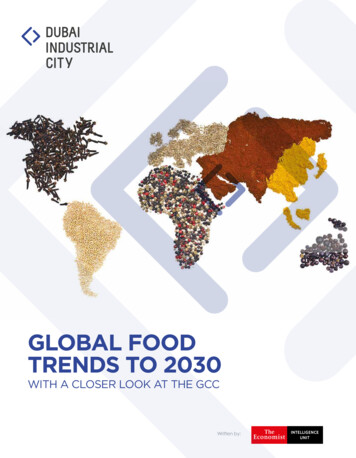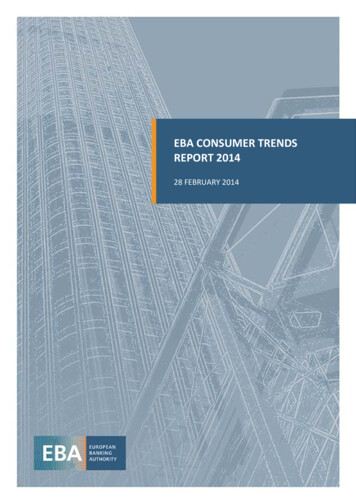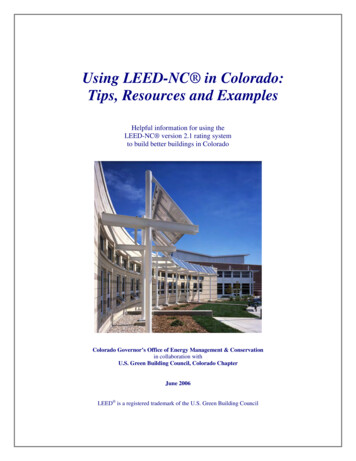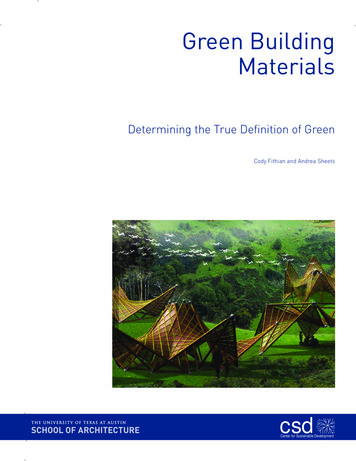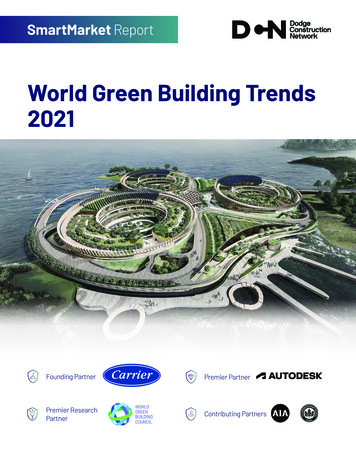
Transcription
SmartMarket ReportWorld Green Building Trends2021Founding PartnerPremier PartnerPremier ResearchPartnerContributing Partners
Design and Construction IntelligenceSmartMarket ReportDodge Construction NetworkChief Executive OfficerWorld Green Building Trends 2021SmartMarket ReportDaniel McCarthyExecutive EditorChief Revenue OfficerManaging EditorDave ColfordStephen A. JonesDonna Laquidara-Carr, Ph.D., LEED APResearch Project ManagerVice President, Data Strategy & OperationsSarah WelcomeSusan Barnett, MRA, PRCArt DirectorJustin McCabeSenior Director, Industry Insights ResearchStephen A. JonesDirector, Industry Insights ResearchDonna Laquidara-Carr, Ph.D., LEED APReproduction or dissemination of any informationcontained herein is granted only by contract or priorwritten permission from Dodge Data & Analytics.Copyright 2021,Dodge Data & Analytics,ALL RIGHTS RESERVEDContributorsLarry BernsteinKatharine LoganMedia ContactCailey Henderson104 West Partnerscailey.henderson@104west.comFor further information on this SmartMarket Reportor for any in the series, please contact:Dodge Construction NetworkResearch & Analytics34 Crosby Drive, Suite 201Bedford, MA mAbout Dodge Construction NetworkDodge Construction Network is North America’s leading provider of commercial construction project data, market forecasting &analytics services and workflow integration solutions for the construction industry. Building product manufacturers, architects,engineers, contractors, and service providers leverage Dodge to identify and pursue unseen growth opportunities that help themgrow their business. On a local, regional or national level, Dodge empowers its customers to better understand their markets,uncover key relationships, seize growth opportunities, and pursue specific sales opportunities with success. The company’sconstruction project information is the most comprehensive and verified in the industry.As of April 15, 2021, Dodge Data & Analytics and The Blue Book--the largest, most active network in the US commercialconstruction industry--combined their businesses in a merger. The Blue Book Network delivers three unparalleled databases ofcompanies, projects, and people.Dodge and The Blue Book offer 10 billion data elements, and 14 million project and document searches. Together, they provide aunified approach for new business generation, business planning, research, and marketing services users can leverage to find thebest partners to complete projects and to engage with customers and prospects to promote projects, products, and services.To learn more, visit www.construction.com and www.thebluebook.com.
SmartMarket ReportWORLD GREEN BUILDING TRENDS 2021IntroductionDodge Data & Analytics and Carrierhave partnered on research on globalgreen building trends since 2008,with this study in its current formfirst done in 2012. The current 2021 research,though, has occurred during a pivotal timeacross the globe. The COVID-19 pandemic hashad a major impact that we are just beginningto understand on industry in general, anddesign and construction in particular.In that atmosphere of change, it isparticularly powerful to see the findings ofthis study. It demonstrates that despite thestate of upheaval, many of the key findings ofprevious studies have not changed. Commitment to increasing green buildingefforts continues to remain strong.Respondents across the globe plan tointensify their green building engagement,with a 14-point growth in the share of thosewho intend to do the majority (more than60%) of their projects green, from 28% doingso now in 2021 to 42% who plan to do so in thefuture. Respondents also expect to use more greenbuilding products and systems, with doubledigit percentage point growth in six productcategories, including building automationsystems, thermal and moisture protection,waste management and the emerging use ofmass timber structural systems. The findings also continue to demonstrate acompelling business case for building green: The average reduction in operatingcosts in the first 12 months for newgreen buildings is 10.5% and five-yearoperating costs savings is 16.9%. Green renovations and retrofits ofexisting buildings have even strongerperformance globally at 11.5% and 17%,respectively. Owners report that green new buildingsand renovation/retrofit projectsincrease the asset value of buildings bymore than 9%.Social factors also continue to be importantdrivers, with improved occupant health andwell-being, and encouraging sustainableSmartMarket Reportbusiness practices rated as important/veryimportant reasons for building green by overthree quarters of respondents. Interestingly,these findings are highly consistent with thosefrom the 2018 study, which suggests that theimportance of creating healthier buildings isnot a response to the pandemic but part of anongoing commitment by green practitioners.However, since 2018, there has been asignificant increase in the share of thosewho report that doing the right thing is oneof the top three triggers for increasing theirgreen building efforts. It ranks second amongowners/investors, and third among designand construction professionals, just belowlong-standing important drivers like loweroperating costs and client demands, and iteven outranks creating healthier buildingsas a trigger for new green building efforts.This finding may be the strongest evidenceof the impact of the times in which we live,in which evidence of the impact of climatechange, such as extreme weather events, isalready deeply felt, and in which the need tomanage the risks associated with worseningeffects, including increasing the risk of futurepandemics, becomes more influential.Another way in which the industry haschanged since 2012 are the various meansavailable to help improve buildings, fromincreasingly common net-zero/net-positivetargets for buildings to controlling embodiedcarbon. For the first time the study exploresthe perceived importance and anticipated useof 10 of these new approaches, suggestingincreasing ways for those engaged in designand construction to improve the performanceof the built environment.Dodge Data & Analytics thanks Carrier fortheir ongoing support of this critical research.We also thank our premier partner Autodeskfor their support and engagement in thisstudy, and our two contributing partners, theUS Green Building Council and the AmericanInstitute of Architects. And we thank all theresearch partners who helped us reach out tothe global design and construction industry,especially our premier research partner, theWorld Green Building Council.1Jennifer AndersonChief Sustainability OfficerCarrierJennifer Anderson leadsCarrier’s environmental,social and governance(ESG) priorities and thedevelopment of thecompany’s associatedstrategic roadmap alignedwith its vision to createsolutions that matter forpeople and our planet. Sheis responsible for makingprogress against Carrier’sambitious 2030 ESG Goals,including reducing itscustomers’ carbon footprintby more than one gigatonand investing over 2 billionto develop healthy, safe,sustainable and intelligentbuilding and cold chainsolutions.Donna Laquidara-Carr,Ph.D., LEED APIndustry InsightsResearch DirectorDodge Data & AnalyticsDonna Laquidara-Carrcurrently provideseditorial direction,analysis and contentto DD&A’s SmartMarket Reports.Prior to this position, sheworked for nearly 20 years withDD&A’s Dodge division, whereshe gained detailed insight intothe construction industry.Dodge Data & Analytics www.construction.com
SmartMarket ReportWORLD GREEN BUILDING TRENDSTABLE OF CONTENTS4 Executive Summary7 Data7 Introduction8 Green Building Market Activity8 Green Building Activity10 Expected Future Green Activity by Sector11 SIDEBAR Standards of Resilience12 Influences on Green Building Markets12 Social Reasons for Building Green14 Environmental Reasons for Building Green16 Triggers to Increase Levels of Green Building18 Top Barriers to Increasing Green Building Activity19 Green Building Rating Systems20 United Nations’ Sustainable Development Goals21 SIDEBAR Building Health: Rising DemandCover Image: Image courtesy of Katrina Urbanik AS. Opposite page: Image courtesy of Lake Flato, copyright Casey Dunn23 Business Benefits of Building Green23 Important Business Benefits of Green Building24 Metrics Used to Measure Benefits of Green Building26 Impact of New Green Buildings on Operating Costs27 Asset Value Increase for New Green Buildings28 Impact of Green Retrofit/Renovation on Operational Costs29 Asset Value Increase Due to Green Renovation/Retrofit Projects32 Green Building Products and Services32 Current and Future Use of Green Building Products and Services34 Criteria for Identifying Green Products35 SIDEBAR Green and Smart Buildings36 Green Building Trends36 Changes to Buildings in Response to COVID-1937 SIDEBAR Reducing Embodied Carbon in the Built Environment38 Embodied Carbon40 Design for Disassembly42 SIDEBAR How Green is Additive Manufacturing?43 Design for Manufacturing and Assembly (DfMA)44 SIDEBAR The Advantages of Design for Manufacturing and Assembly45 Most Important Green Building ApproachesSmartMarket Report2Dodge Data & Analytics www.construction.com
Above: The Hotel Magdalena is the first mass timber boutique hotel in North America.Cover Photo: Rendering for WILD, a new urban development on a human-made island. Its design has thecapability to produce its own power, fresh water, food and heat as a closed biotope loop system.47 Regional Data: Green Building Activity and Trends47 Australia and New Zealand51 Asia55 Europe59 Latin America63 Middle East and North Africa67 Canada/US71 Sub-Saharan AfricaCase Study30 Prioritizing Healthier and More Efficient Buildings: HVAC Modernization at One Court SquareLong Island City, New YorkThought Leader Interview22 Cristina Gamboa, CEO, World Green Building Council75 Methodology77 ResourcesSmartMarket Report3Dodge Data & Analytics www.construction.com
Executive SummaryWORLD GREEN BUILDING TRENDS 2021Green Market ActivityLevel of Green Building Activity(According to All Respondents)The 2021 World Green Building Trends Study demonstrates thesame commitment to increasing green building activity ashave the previous studies in 2018, 2015 and 2012. As the chartat upper right shows, there is a high level of growth expectedin the next three years among those who anticipate doingmore than 60% of their projects green, and a correspondingreduction in those who plan on engaging in fewer than 15%green projects.These findings show that green building continues toremain a global priority, likely driven by increasing extremeweather events and despite other rising concerns like theglobal pandemic.Dodge Data & Analytics, 202142%28%20%24% 16%14%13% 19%Use of Rating Systems2021While the study reveals a slight decline in the share of greenprojects that use a rating system, especially in long-standinggreen markets, it also clearly demonstrates that the vastmajority of green projects still employ one. The respondentsusing one report that they value it most for its ability to createbetter-performing buildings, provide third-party verificationthat a building is green and offer marketing and competitiveadvantages.8%16%20241% to 15% of ProjectsMore Than 60% of ProjectsExploring (No Green Involvement)31% to 60% of Projects16% to 30% of ProjectsSocial Reasons to Build GreenRated Important/Very ImportantDodge Data & Analytics, 2021Use of Green ProductsPromotes Improved OccupantHealth and Well-BeingGrowth is expected in the use of green products andsystems across nine different categories, with the top onesfor anticipated use being electrical, mechanical, buildingautomation systems, and thermal and moisture protection.Encourages SustainableBusiness PracticesIncreases Worker ProductivityInfluences on GreenBuilding MarketsSupports the DomesticEconomyCreates a Sense of CommunityEnvironmental and Social Reasons forBuilding GreenRespondents to this study have been asked to rate theimportance of the same set of environmental and socialreasons for building green since 2012.76%59%58%57%SOCIAL REASONSAs the chart at lower right reveals, green building alsocontinues to be driven by social reasons as well asenvironmental ones, with improved occupant health andwell-being, and encouraging sustainable business practicesthe most dominant factors. However, increased workerproductivity, supporting the domestic economy and creating asense of community are also considered important influencesby over half of respondents.ENVIRONMENTAL REASONSAll of the environmental reasons for building green includedin the study—reduce energy consumption, lower greenhousegas emissions, improve indoor air quality, reduce waterconsumption and protect natural resources—are selectedby over three quarters of the respondents as important, withreducing energy consumption topping the list at 87%. The environmental reason with the greatest and mostconsistent growth since 2012 is improved indoor air quality.SmartMarket Report80%4Dodge Data & Analytics www.construction.com
Executive SummaryWORLD GREEN BUILDING TRENDS 2021Influences on Green Building MarketsCONTINUEDTop Triggers for Increasing Green BuildingSelected by One Quarter or More RespondentsTop Triggers for Increasing Green BuildingThe table at upper right shows that client demands are thetop driver for construction industry practitioners, alongwith environmental regulations. Therefore, the triggersencouraging owners and investors to increase their greenbuilding efforts are critical to drive the industry forward.Lower operating costs is the top trigger for owners/investors,and it is also ranked first as the most important businessbenefit of building green globally.In 2021, increasing green building because it is the rightthing to do also increased compared with the findings in 2018,emerging in the top three for both practitioners and owners.This has no doubt been driven by greater concerns aboutthe impacts of climate change and a more intense focus onhealthier buildings driven by the pandemic. Creating healthierbuildings also continues to be an important trigger, as it was in2018, and improving occupant health and well-being remainsone of the critical business benefits of green building, rankingnearly as high as operating cost savings.Dodge Data & Analytics, rs1. Lower Operating Costs1. Client Demands2. Right Thing to Do2. Environmental Regulations3. Healthier Buildings3. Right Thing to Do4. Internal Corporate Commitment4. Healthier Buildings5. Environmental Regulations5. Lower Operating CostsMost Important Business Benefits of Green BuildingDodge Data & Analytics, 202166%Lower Operating CostsFinancial Benefits ofBuilding GreenImproved User/OccupantHealth and Well-BeingAs the table at lower right shows, average operating costsavings within the first 12 months exceed 10% and the fiveyear cost savings exceed 16%. Owners and investors report9% growth in building asset value due to investments in bothnew green buildings and green renovations/retrofits. Clearly,green buildings are helping to drive the operating cost savingssought, and provide more value to the asset owners.62%Future-Proofing Assets33%Education of Users/OccupantsAbout ing Quality Assurance32%Financial Benefits of Building Green, Compared WithTraditional BuildingsIMPACT OF HIGH GREEN INVOLVEMENTRespondents who do more than 60% of their projects greenbenefit from their increased knowledge of and experiencewith green building and are able to achieve better results. Those with a high level of green involvement track operatingcosts more often, with 71% reporting doing so comparedwith the global average of 59%. Therefore, it is particularly notable that they reportoperational cost savings of over 16% on new green buildingsand retrofits in the first year, and over 20% on greenrenovations/retrofits.Dodge Data & Analytics, 2021New GreenBuildingsGreen Renovation/RetrofitAverage Reduction in Operating Costsin Next 12 Months10.5%11.5%Average Reduction in Operating Costs inNext 5 Years16.9%17%Average Increase in Asset Value(According to Owners/Investors)9.2%9.1%These findings suggest that as organizations intensify theirgreen building involvement, it can help them achieve thetop benefits sought, which can encourage even greaterinvestment, reinforcing a virtuous cycle.SmartMarket Report5Dodge Data & Analytics www.construction.com
Executive SummaryWORLD GREEN BUILDING TRENDS 2021Emerging Approaches to Building GreenMost Important Approaches to ImproveSustainability in the Design and ConstructionIndustry in the Next Five YearsMany strategies to improve building performance and theconstruction of green projects have gained in prominencesince the 2012 survey, so in the current study, new questionswere added to examine some of these approaches. The chartat right shows those selected among the top three mostimportant by global respondents and the share who believethey will use them in the next five years. Strategies for reducing energy use and radically altering thebuilt environment’s carbon footprint top the list. New approaches for building, such as modular constructionand design for disassembly and recovery, are alsoconsidered among the most important by at least onequarter, roughly the share that intend to employ them.Dodge Data & Analytics, 2021Creation of NetZero/Net-PositiveBuildings47%46%37%Controlling EmbodiedCarbonIn addition, the study did a deeper dive on controllingembodied carbon, design for disassembly and recovery, anddesign for manufacturing and assembly.44%Strategies toIncrease Resiliency32%Passive BuildingDesign31%Prefabrication andModular Construction31%42%38%43%Design forDisassembly andRecoveryEmbodied CarbonWith embodied carbon ranking second in both importance andanticipated future engagement, it is clear that efforts to trackand reduce it should continue to grow in the next few years. Most of the respondents (72%) are at least familiar with theconcept of embodied carbon, and 34% are tracking it onsome of their projects, with two thirds of them also seekingto reduce it. The top factors that will drive more engagement with dealingwith embodied carbon are more information about how toreduce it and more building products/materials on offer thatcan help to do so.25%26%AI, Generative Designand Machine Learningto Improve ConstructionProcess**23%28%18%AI, Generative Designand Machine Learning toImprove Design Process*21%12%Biophilic DesignMass TimberDesign for Disassembly and Recovery23%9%Ranked in the Top ThreeMost ImportantA critical way to reduce carbon and waste in the builtenvironment is to have building products and buildingsdesigned so that the various components can be reused whenthe building reaches the end of its lifecycle. Owners have thegreatest influence in driving use of this approach, but fewerthan half are currently familiar with it.17%Likely to Be Used onTheir Projects*According to Architects and Owners**According to Contractors and OwnersDesign for Manufacturing and AssemblyA little over half of the global respondents are familiar withdesign for manufacturing and assembly (DfMA), and abouttwo thirds of those who are familiar with it have used it onprojects. However, use is still emerging, currently limited to10% or fewer projects for the majority of those deploying thisapproach.SmartMarket Report6Dodge Data & Analytics www.construction.com
Data: IntroductionThe current study is the fourth in a series that has usedthe same questions to measure trending changesin green building over time. The studies have beenconducted on a three-year cycle, beginning in 2012.In the previous survey releases since then, questions havebeen slightly tweaked to reflect more current green buildingpriorities, but this 2021 study included the most extensivereexamination of the questions since the start of this research.This reconsideration of elements of the survey was done tohelp allow the study to expand into looking at approaches thatare more widely considered for use currently than they were in2012. This includes a few questions to benchmark engagementwith tracking and reducing embodied carbon in buildings,use of design for disassembly and reuse, and use of designfor manufacturing and assembly. In addition, two questionswere added about a series of approaches to building green notpreviously included in the study, including most of the itemsshown above, along with the pursuit of net-zero/net-positivebuildings, design for resiliency, the use of mass timber andseveral other approaches. One question asked respondentsto select the top three most important to achieve future greenbuilding goals. The other asked them to identify which they planto use in the next five years. These responses are instructivenow and will serve as an important benchmark for future studieson the practices considered most valuable across the globe andwithin specific markets.Despite this reconsideration, though, many questionsstill remained sufficiently the same to track green buildingtrends. These include questions examining overall greenbuilding activity (although the definition of what qualifiesas a green building was slightly modified this year), the topsocial and environmental factors for building green, thetriggers and barriers for expanding green building efforts,the business benefits of green buildings and the use of greenbuilding products. These findings demonstrate a continuedcommitment to green building, well founded in the businessbenefits provided by these approaches.Finally, given the pervasive influence of the pandemicglobally and in every industry sector, this 2021 study includedexamining what changes in approaches brought about by thepandemic will be more widely adopted by the industry. Thebroad realization by the general public of the degree to whichthe built environment can impact their health will no doubthave lasting implications for green building efforts, so a betterunderstanding of the changes brought about during this timewill aid in better understanding the future of green building.SmartMarket Report7Note About the DataThe data and analysis in this report are drawnfrom 1,207 respondents to an online survey thatwas administered from June to August 2021.Respondents include architects/designers,engineers, consultants, contractors, owners/developers and investors. The analysis of theresponses by type of company focuses primarily onindustry practitioners in the AEC community and onowners/developers and investors.Overall, the types of participants are consistentwith earlier studies conducted in 2012, 2015 and2018, with one exception: Previously those doingmore than 50% horizontal construction (e.g.,roads, bridges, water treatment plants, etc.) werescreened out, but in this study, they were includedfor all applicable questions. However, only 8% ofrespondents fell into this categoy.The analysis also includes countries with asufficient sample for statistical analysis. Typically,the minimum number has been 30 respondents.However, given the smaller size of the buildingmarket compared with many other countries, thedecision was made to also include Cameroon,which had a total of 27 responses.For more information on the study and therespondents, see the Methodology section on pages75 and 76.Dodge Data & Analytics www.construction.com
Data: Green Building Market ActivityWORLD GREEN BUILDING TRENDS 2021 DATAGreen Building ActivityLevel of Green Building Activity(According to All Respondents)All survey respondents were asked two questions about theirlevel of green building activity: The overall share of current green projects and of greenprojects expected by 2024 for each respondent based on adefinition of green building The current and expected future share of their projectsregistered and/or certified under a green buildingcertification systemDodge Data & Analytics, 202142%28%To determine the overall share, the following definition of agreen project was provided in the survey:14%13% 19%At a minimum, for a building project to be considered green, itmust include the following: Efficient use of energy, water and other resources Pollution and waste reduction measures, and the enabling ofreuse and recycling Good indoor environmental air quality Consideration of the environment in design, construction andoperationIn addition, green building projects include as many of thefollowing as possible: Use of renewable energy, such as solar energy Use of materials that are nontoxic, ethical and sustainable A design that enables adaptation to a changing environment A commitment to net zero carbon emissions8%202116%20241% to 15% of ProjectsMore Than 60% of ProjectsExploring (No Green Involvement)31% to 60% of Projects16% to 30% of ProjectsShare of Green Versus Certified Projects(According to Those With More Than 60%Green Projects)42%Dodge Data & Analytics, 20219%28%27%33%7%5%The chart at the upper right shows the overall share of greenprojects reported by all respondents based on this definition. Notably, most respondents expect a larger share of theirprojects to be green by 2024 than their current share ofprojects, including steep growth in those who expect themajority of their projects to be green. In 2018, when the same question was asked, roughly thesame percentage of respondents (27%) reported that themajority of their projects were green. However, there wasa slightly smaller percentage (31%) who reported that theyhave 15% or fewer green projects than the share (37%) whocurrently report this. One factor that may contribute to these findings is theinclusion in 2021 of organizations that largely do civil/horizontal projects, in addition to those who specializein vertical projects. Another factor that likely influences this finding isthat there are fewer respondents from countries withhistorically high levels of green building, such as thosein Western Europe and Scandinavia, in the current studythan in 2018.SmartMarket Report20%24% 16%22%21%20182021Certified Green Projects2024All Green ProjectsVariation in Overall Findings Between Greenand Certified ProjectsThe chart above compares the responses of those who reportthat the majority of their projects meet the definition ofgreen provided in the survey with those who have registered/certified projects with a green certification system. It includesthe findings in 2018, the current share in 2021 and the expectedshare in 2024.Notably, it confirms a trend first observed in 2018 thatsuggests a small shift away from using certification systemsfor green projects.8Dodge Data & Analytics www.construction.com
Green Building Market ActivityWORLD GREEN BUILDING TRENDS 2021 DATAGreen Building ActivityCONTINUEDPercentage of Respondents Whose FirmsHave More Than 60% Green ProjectsIn 2018, the difference between those reporting a majorityof green projects using the definition and those reportinga majority of registered/certified projects was fivepercentage points. By 2021, that difference increased to seven points, and by2024, it is expected to grow again to nine percentage points. Dodge Data & Analytics, 202161%55%48%47%39%It is clear from the these findings that it is still common formost organizations doing projects green enough to meet therigorous definition provided in the survey to seek to certifymost of those projects with a green rating system. However,as experience with green building continues to grow, it is clearthat in a small but growing number of cases, companies arebuilding green without seeking that external certification.35%32%25% iation in High Green Building Activity byCountry25%The chart at upper right shows the share of those currentlydoing a majority of their projects green and those who expectto do so by 2024 in the 13 countries that had a sufficiently largeenough response rate to analyze separately in the study. The highest levels of current activity are in Australia/NewZealand, Canada and the US. The highest levels of growth in those doing a majority ofgreen projects are expected in Brazil, Colombia, Canada Singapore2021SouthAfricaUS2024Countries With Largest Difference BetweenGreen and Certified Projects in 2021(Difference of 5% or More)The chart at lower right shows the countries with the greatestdifferences in the majority of green projects versus certifiedprojects. Notably, the top three in this category are also thetop three with the highest level of green projects overall,which again suggests that higher levels of experience withgreen may be a factor in the choice to build green withoutpursuing certification.Dodge Data & Analytics, 202148%34%28%35%23%22%24%Variation by Type of Organization17%12%Owners most frequently report a majority share of greenprojects, with 37% stating that 60% or more of their projectsare green.On the other hand, general contractors (13%) and investors(14%) are least likely to report that the majority of their projectsare green, with architects and engineers falling in the middle.SmartMarket ll Green9SouthAfrica6%SaudiArabiaCertifiedDodge Data & Analytics www.construction.com
Green Building Market ActivityWORLD GREEN BUILDING TRENDS 2021 DATAExpected Future Green Activity by SectorSectors With Planned Green Activity Overthe Next Three Years (Global Average and FiveHighest Averages by Country)All respondents who plan to do green projects were asked inwhich sectors they expect to build green. The chart at rightshows the total global average for each sector included inthe study and the top five countries/regions in which thosesectors were selected. No single sector is selected by more than half of therespondents, revealing a wid
Dodge Construction Network. Research & Analytics. 34 Crosby Drive, Suite 201. Bedford, MA 01730 1-800-591-4462 Dodge.Analytics@construction.com Design and Construction Intelligence. About Dodge Construction Network. Dodge Construction Network is North America's leading provider of commercial construction project data, market forecasting &
